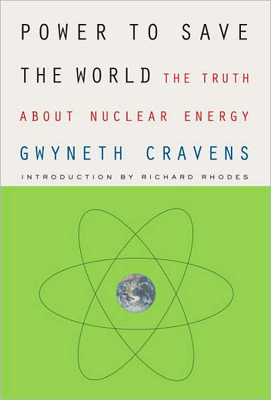

| POWER TO SAVE THE WORLD The Truth About Nuclear Energy Gwyneth Cravens Richard Rhodes (Intro.) New York: Alfred A. Knopf, 2007 |
Rating: 5.0 High |
|||
| ISBN-13 978-0-307-26656-9 | ||||
| ISBN-10 0-307-26656-7 | 439p. | HC/BWI | $27.95 | |
In the beginning, Gwyneth Cravens felt the power of the atom, with its invisible radiation and its deadly waste products, was too perilous to be used for generating electrical power. She considered hydroelectric, wind and solar to be what would save us from fossil fuels. But, with the help of a chemist she calls "Dr. Rip", she embarked on a quest to learn the truth about nuclear power.
Dr. Rip, or just Rip, is D. Richard Anderson, Ph.D., formerly in charge of radioactive waste remediation programs at Sandia National Laboratory. He was her Virgil on this quest. Like the Virgil who escorted Dante in The Inferno, he guided her through what she had thought of as the Circles of Hell — the vast infrastructure built during World War II and the Cold War to harness the awesome new power of the atom. (At the end of that quest, she had revised her outlook. Now it was coal-fired power plants that in her imagination stood in for Hell.)
Ms. Cravens's journey of discovery leads her far from her home on Long Island1 to a number of out-of-the-way places: the Idaho National Laboratory, Oconee Nuclear Plant, Yucca Mountain, and finally the Waste Isolation Pilot Plant in southern New Mexico. Along the way she discourses with Rip and sometimes with his wife Marcia, who shares some of their journeys. The narrative also contains a number of interviews with other experts, and a good deal of supporting material. Charts and photographs are used to good effect. At the back of the book are notes on 372 sources, an extensive glossary, acknowledgements, and of course an index.
Coal-fired plants are dirtier than nuclear power plants. Mining coal disrupts more land surface and endangers more people than does mining uranium. When coal is burned to make electricity, mercury and other poisons blow out of those smokestacks. Coal produces many times the volume of toxic waste that nuclear plants do. And only coal plants produce carbon dioxide. Coal's only advantage is that the public does not fear it like they do nuclear. Consider:
During the Manhattan Project, 26 men at Los Alamos acquired a significant body burden of plutonium. Their average exposure was 1,000 mREM. Fifty years after they were contaminated, 19 members of the group (average age 72) were found to be in good health; they had produced normal children and grandchildren. Most U.S. soil naturally emits more radiation than any nuclear plant in the country. Some inhabited places are hotter still.3 The bottom line is that the public fears nuclear energy far more than it should, and coal far less.
The author has no technical training, and makes some elementary mistakes in a few places. There are also explanatory passages that would benefit greatly from being tightened up. Despite all this, she has produced an engrossing and informative book that anyone struggling with the question of whether to support nuclear power as an option in this age of global warming will find eye-opening and valuable. It was an eye-opening book for me, and I was fairly well-versed on matters nuclear. None of those mistakes diminishes the essential message of the book, which is that nuclear power can, if competently managed, be an important part of a new energy strategy for America — along with renewables like wind, solar, geothermal, and ocean power of course.
"Rip and the scientists we met who were thinking about future energy resources didn't oppose the renewable ones—I never met anyone in the nuclear world who did, and in fact encountered some enthusiastic fans. But those experts considered expectations about wind and solar power as unrealistic as some of the early claims made on behalf of nuclear energy. The scientists who were accustomed to looking at the entire life cycle of energy resources debunked the assumption that renewables were environmentally immaculate." – Page 248 |
This book and its message have my highest recommendation. And the most valuable part of that message may be that Yucca Mountain will not be needed if we get the IFR or AFR off the drawing boards and start reprocessing our nuclear waste. Those advanced reactor designs promise to reduce the volume of reactor waste by a factor of 100, and remove its longest-lived components into the bargain.

 To contact Chris Winter, send email to this address.
To contact Chris Winter, send email to this address.